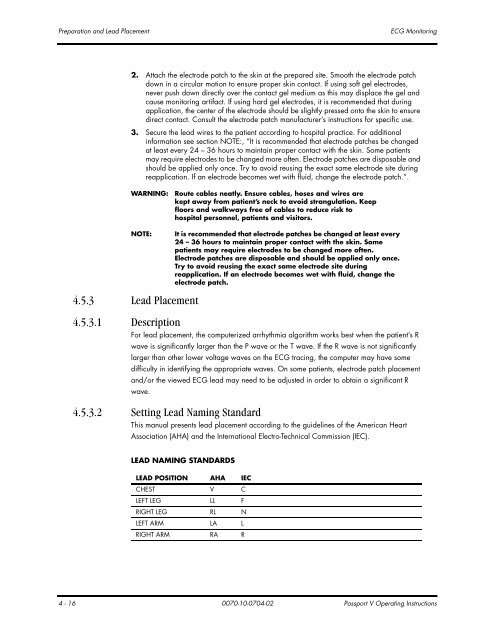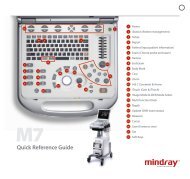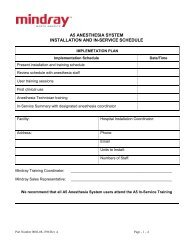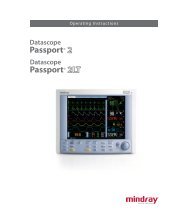Passport® - Mindray
Passport® - Mindray
Passport® - Mindray
- TAGS
- mindray
- res.mindray.com
You also want an ePaper? Increase the reach of your titles
YUMPU automatically turns print PDFs into web optimized ePapers that Google loves.
Preparation and Lead Placement ECG Monitoring<br />
2. Attach the electrode patch to the skin at the prepared site. Smooth the electrode patch<br />
down in a circular motion to ensure proper skin contact. If using soft gel electrodes,<br />
never push down directly over the contact gel medium as this may displace the gel and<br />
cause monitoring artifact. If using hard gel electrodes, it is recommended that during<br />
application, the center of the electrode should be slightly pressed onto the skin to ensure<br />
direct contact. Consult the electrode patch manufacturer’s instructions for specific use.<br />
3. Secure the lead wires to the patient according to hospital practice. For additional<br />
information see section NOTE:, “It is recommended that electrode patches be changed<br />
at least every 24 – 36 hours to maintain proper contact with the skin. Some patients<br />
may require electrodes to be changed more often. Electrode patches are disposable and<br />
should be applied only once. Try to avoid reusing the exact same electrode site during<br />
reapplication. If an electrode becomes wet with fluid, change the electrode patch.”.<br />
WARNING: Route cables neatly. Ensure cables, hoses and wires are<br />
kept away from patient’s neck to avoid strangulation. Keep<br />
floors and walkways free of cables to reduce risk to<br />
hospital personnel, patients and visitors.<br />
NOTE: It is recommended that electrode patches be changed at least every<br />
24 – 36 hours to maintain proper contact with the skin. Some<br />
patients may require electrodes to be changed more often.<br />
Electrode patches are disposable and should be applied only once.<br />
Try to avoid reusing the exact same electrode site during<br />
reapplication. If an electrode becomes wet with fluid, change the<br />
electrode patch.<br />
4.5.3 Lead Placement<br />
4.5.3.1 Description<br />
For lead placement, the computerized arrhythmia algorithm works best when the patient’s R<br />
wave is significantly larger than the P wave or the T wave. If the R wave is not significantly<br />
larger than other lower voltage waves on the ECG tracing, the computer may have some<br />
difficulty in identifying the appropriate waves. On some patients, electrode patch placement<br />
and/or the viewed ECG lead may need to be adjusted in order to obtain a significant R<br />
wave.<br />
4.5.3.2 Setting Lead Naming Standard<br />
This manual presents lead placement according to the guidelines of the American Heart<br />
Association (AHA) and the International Electro-Technical Commission (IEC).<br />
LEAD NAMING STANDARDS<br />
LEAD POSITION AHA IEC<br />
CHEST V C<br />
LEFT LEG LL F<br />
RIGHT LEG RL N<br />
LEFT ARM LA L<br />
RIGHT ARM RA R<br />
4 - 16 0070-10-0704-02 Passport V Operating Instructions












